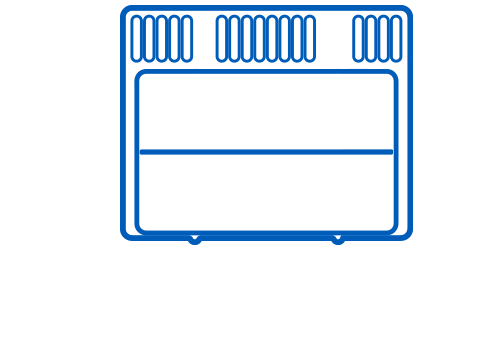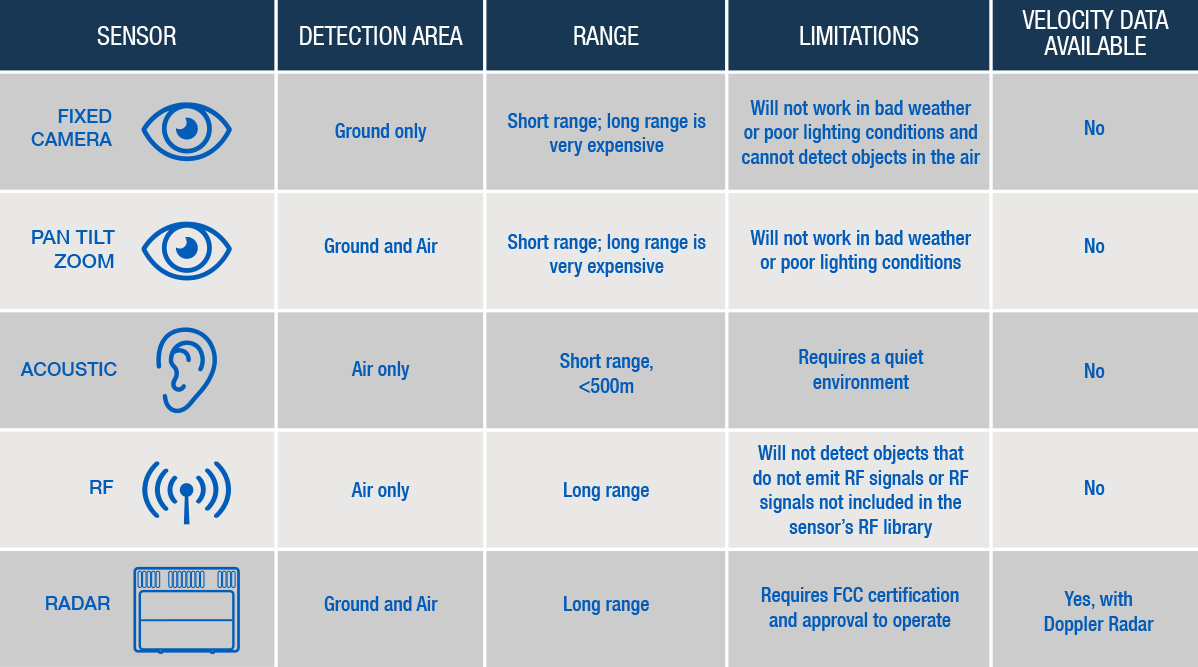PART 2
Why Use Radar for Situational Awareness?
Situational awareness of movement by people, vehicles, vessels, and drones is an essential requirement for ensuring the safety of communities and gatherings as well as the success of military and national security missions. Today, there are a number of sensors and tools available for achieving situational awareness of a wide range of airborne, terrestrial, and maritime objects. This includes external data sources such as cameras, acoustic sensors, RF systems, and radar as well as tools like the UAS Traffic Management (UTM) and other pertinent data sources. So how does one know which tools are best for the application’s situational awareness needs?
The short answer is that comprehensive coverage is achieved through a layered solution of sensors, software, and data to create a complete and accurate picture of the operating area. The command and control software layer, or just C2, is where both sensor performance and use case differences are magnified and compounded. Sluggish data updates or poor positional accuracy may seem small, but manageable challenges are magnified when the result is optical sensors that can neither locate nor follow a drone intrusion. There are significant performance and application distinctions between the different sensor types that must be considered during planning, deployment, and operational phases.
Radar: The Baseline for Superior Situational Awareness
As discussed in Part 1 of this series, radar provides four key data dimensions of an object – azimuth, elevation, range, and velocity. This radar data serves as an essential baseline for all other tools used in the surveillance system.
This precision data is necessary for other sensors to perform well. The easiest example is found in every security process - to get “eyes on object” to determine risk and direct further actions. Optical sensors used to identify drones and follow their flight path are cued by radar data to lock on a target, requiring data rates that match drone speed and positional accuracy to track flight path. Drone agility and speed also require highly accurate radar data flows for optical- or laser-based fire control solutions.
Radar itself has many benefits including the following:
- Works reliably in all weather and lighting conditions
- Detects all movement in the air, on the ground, or in the water at long range
- Maintains individual privacy as electromagnetic waves (EWs) are used for detection, not RF signals or cameras
- Provides velocity information when Doppler radar technology is incorporated, which is key information for quickly determining if an object is moving towards or away from the base station and how much time is available to respond, intercept, or deconflict.
- Micro-Doppler is also an essential capability for both detecting hovering drones and detailed classification of any drone type.
- Produces highly actionable data and the most comprehensive data baseline - other sensors and overall system performance all rely on radar.
To build on this last point, let’s dive into details of the other sensors commonly used in conjunction with radar.
Acoustic sensors
Detect and track drones by their acoustic signature. These sensors are ideal for sensitive facilities in remote locations, but acoustic sensors will face challenges when used in locations with high background noise and are inherently range limited.
Electro-Optical/InfraRed (EO/IR)
Also known simply as optical sensors, these sensors are essential as every security process requires “eyes on object” to determine response actions. Many facilities use dozens to hundreds of optical sensors that are primarily cameras fixed to stare at the ground plane. For a counter-drone system, a pan-tilt-zoom (PTZ) optical sensor is required.
Radio Frequency (RF) sensors
These sensors can be powerful tools in the counter-drone system but must be used carefully as there are potential individual privacy and legal implications. We will explore RF sensors in detail in the next chapter.
UTM data feeds
As drones take to the air for commercial purposes, their flight plans will be filed and distributed through a network of data services. This concept is called UAS Traffic Management (UTM). Having this set of known traffic available helps distinguish rogue drones from commercially scheduled flights.
A comparison of the most common detection, tracking, and locating technologies used today.
Evolving Radar to Support Additional Applications that Require Situational Awareness
Historically, high-performance radar was used solely for object detection for military and national security applications. Because national security threats have conventionally focused on high-flying missiles, bombers, and fighter jets with relatively straight trajectories or on force protection systems, such as active protection systems, these conventional radar systems have been a great fit. High-performance radar systems are rarely used for applications beyond national security though because these systems have:
- High size, weight, and power (SWaP)
- High acquisition costs
- High operational/lifecycle costs
Phased arrays commonly used in military and national security applications for example are generally large and the phase shifters are mechanical parts that generate heat, increasing operational costs as these systems need to be cooled. These components also require maintenance, including significant tuning and calibration, further driving up lifecycle costs.
To provide a radar-like solution at the opposite end of the spectrum cost-wise, angle-of-arrival (AoA) radars emerged. This relatively small and inexpensive radar technology does not use beamforming, making these systems very inefficient. While AoA radars can generally provide sufficient situational awareness when it comes to knowing if an object such as a small plane is in the area, these radars usually cannot offer details on exactly where an object is located, making them insufficient to use for security purposes. Additionally, most AoA radars provide two-dimensional coverage so these systems can only see the ground, typically at <500m. While some AoA radars can provide three-dimensional surveillance of air and ground space, the coverage is typically insufficient and these devices cannot detect small threats such as drones.
With rapid growth in drone usage, demand for a radar solution for comprehensive object detection in new safety applications is emerging. Until recently, the SWaP-C of ESA radar systems and performance limitations of AoA radars were big barriers to entry for applications that require drone detection – radar was either too big and expensive or too small and ineffective. After many years of research and significant innovation, a breakthrough low SWaP-C radar system employing a novel antenna architecture, metamaterials electronically scanned array (MESA®), is finally removing these barriers. MESA radars are more appropriately tailored for this new threat (drones) and create symmetry in technology and cost between the threat and the threat detection system.
In Part 3, we will dive into more details on the role of RF sensors and the differences between using RF sensors and radar for situational awareness.



